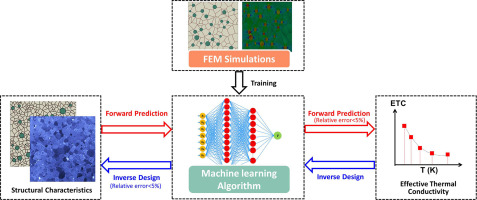当前位置:
X-MOL 学术
›
Mater. Des.
›
论文详情
Our official English website, www.x-mol.net, welcomes your
feedback! (Note: you will need to create a separate account there.)
Bi-directional prediction of structural characteristics and effective thermal conductivities of composite fuels through learning from finite element simulation results
Materials & Design ( IF 7.6 ) Pub Date : 2020-04-01 , DOI: 10.1016/j.matdes.2020.108483 Biaojie Yan , Liang Cheng , Bingqing Li , Pengchuang Liu , Xin Wang , Rui Gao , Zhenliang Yang , Songhua Xu , Xiangdong Ding , Pengcheng Zhang
Materials & Design ( IF 7.6 ) Pub Date : 2020-04-01 , DOI: 10.1016/j.matdes.2020.108483 Biaojie Yan , Liang Cheng , Bingqing Li , Pengchuang Liu , Xin Wang , Rui Gao , Zhenliang Yang , Songhua Xu , Xiangdong Ding , Pengcheng Zhang

|
Abstract Uranium dioxide (UO2) is widely used in nuclear reactors. This fuel has a low thermal conductivity (TC). Increasing its TC can effectively enhance the safety of reactors and fuel efficiencies. A prevalent approach to increasing the TC of UO2 is to inject a second phase material with a high TC into a UO2 matrix. Due to operational difficulties in the fabrication, deployment, and testing of such composite fuels, measurement data regarding effective thermal conductivity (ETC) of these composite fuels are rarely available, which hinders the development of these composites. To overcome such a barrier, finite element method is utilized to generate massive simulated measurements over the concerned composites. Subsequently, a novel algorithmic method is developed that automatically learns from gathered simulation results to accurately and reliably: 1) predict the ETC of a composite fuel according to its given structural characteristics, and 2) reversely infer the structural characteristics of a composite fuel from its expected ETC. The relative error of forward prediction and inverse design is
中文翻译:

通过学习有限元模拟结果双向预测复合燃料的结构特征和有效热导率
摘要 二氧化铀(UO2)广泛用于核反应堆。这种燃料具有低热导率 (TC)。增加其TC可以有效提高反应堆的安全性和燃料效率。增加 UO2 TC 的普遍方法是将具有高 TC 的第二相材料注入 UO2 基质中。由于此类复合燃料在制造、部署和测试方面的操作困难,关于这些复合燃料的有效热导率 (ETC) 的测量数据很少可用,这阻碍了这些复合材料的发展。为了克服这样的障碍,利用有限元方法在相关复合材料上生成大量模拟测量。随后,开发了一种新的算法方法,可以从收集的模拟结果中自动学习,以准确可靠地:1) 根据给定的结构特征预测复合燃料的 ETC,以及 2) 从其预期的 ETC 反向推断复合燃料的结构特征. 正向预测和逆向设计的相对误差为
更新日期:2020-04-01
中文翻译:

通过学习有限元模拟结果双向预测复合燃料的结构特征和有效热导率
摘要 二氧化铀(UO2)广泛用于核反应堆。这种燃料具有低热导率 (TC)。增加其TC可以有效提高反应堆的安全性和燃料效率。增加 UO2 TC 的普遍方法是将具有高 TC 的第二相材料注入 UO2 基质中。由于此类复合燃料在制造、部署和测试方面的操作困难,关于这些复合燃料的有效热导率 (ETC) 的测量数据很少可用,这阻碍了这些复合材料的发展。为了克服这样的障碍,利用有限元方法在相关复合材料上生成大量模拟测量。随后,开发了一种新的算法方法,可以从收集的模拟结果中自动学习,以准确可靠地:1) 根据给定的结构特征预测复合燃料的 ETC,以及 2) 从其预期的 ETC 反向推断复合燃料的结构特征. 正向预测和逆向设计的相对误差为









































 京公网安备 11010802027423号
京公网安备 11010802027423号